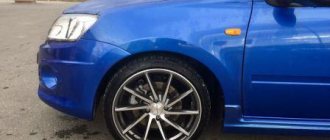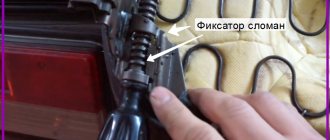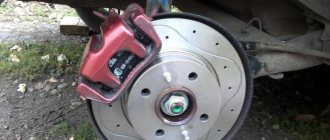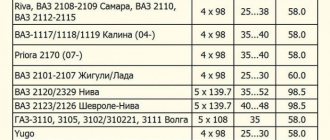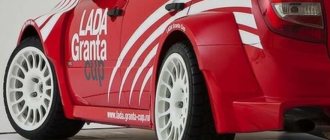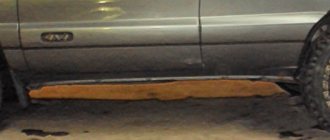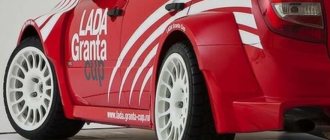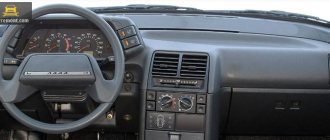Kia Rio is a city family car, classified according to the European classification as class “B”. It has a large interior and a spacious trunk, and is economical in fuel consumption, which distinguishes it very favorably from more bulky cars of class “C” and higher. Let's look at what wheel sizes can be installed on the Rio, and also give recommendations on choosing tires.
Understanding the sizes
The Kia Rio appeared on the European market at the turn of the millennium, in 2000. This was the first generation, produced until 2005 in the following bodies: a five-door hatchback and a sedan.
Year 2000-2005
Several Kia Motors subsidiaries worked on the design of the first Rio. The Japanese branch developed concepts for American and Asian countries, while the European ones tried to satisfy the tastes of their market.
In any case, the car's debut was noisy, and it itself had a very decent exterior and interior design.
The dimensions of the Rio-1 wheels were as follows:
| Modifications | What is the wheel diameter and bolt pattern? | Tire size for Kia Rio | |||
| hub | basic | replacement options | base | replacement options | |
| 1.3I; 1.5I | 54,1 | 5.5Jx13 4/100 ET 40 | 5Jx13 4/100 ET 40 5.5Jx14 4/100 ET 40 | 175/70 R13 | 155/80 R13 175/65 R14 |
| 1.3I (82 лс); 1.5I (95 лс) | 54,1 | 5.5Jx13 4/100 ET 40 | 5.5Jx14 4/100 ET 40 | 175/70 R13 | 175/65 R14 |
| 1.6I | 54,1 | 5.5Jx14 4/100 ET 40 | No options | 175/65 R14 | No options |
| 1.5CRDI | 54,1 | 5Jx14 4/100 ET 39 | 5.5Jx14 4/100 ET 46 5.5Jx15 4/100 ET 46 6.5Jx16 4/100 ET 46 | 175/70 R14 | 185/65 R14 195/55 R15 205/45 R16 |
Year 2006-2011
The second coming of the model called Kia Rio coincided with the beginning of the transformation of Kia Motors. The reorganization turned out to be very effective, and brought this company to the group of world leaders in auto production.
This could not but affect the updated generation of Rio, which debuted in American Detroit in 2005. In fact, the car has already gone beyond the “B” class - it has become larger in size, including an increase in the radius of tires and wheels.
Let's see which wheels are suitable for the second generation Kia Rio - both basic and interchangeable:
| Modifications | What wheels are on the Kia Rio2 | What tire size | |||
| hub | basic | replacement options | base | replacement options | |
| 1.4I; 1.5CRDI; 1.6I | 54,1 | 5Jx14 4/100 ET 39 | 5.5Jx14 4/100 ET 46 5.5Jx15 4/100 ET 46 6.5Jx16 4/100 ET 46 | 175/70 R14 | 185/65 R14 195/55 R15 205/45 R16 |
| 1.1 CRDI; 1.2I; 1.4CRDI | 54,1 | 5.5Jx15 4/100 ET 36 6Jx16 4/100 ET 43 6.5Jx17 4/100 ET 43 | 6Jx15 4/100 ET 48 6Jx16 4/100 ET 52 | 185/65 R15 195/55 R16 205/45 R17 | 185/65 R15 195/55 R16 |
Year 2012 -2016
The next, third generation was presented in 2011 in Geneva. And in fact, under the same name, a completely different car was released.
Dynamic and very distinctive 3- and 5-door hatchbacks and elegant sedans with stylish instrument clusters, climate control and comfortable seats were offered for the European market.
The basic set of wheels has moved from 13 and 14 radii to 16 and 17 inches, which previously could only be used as a replacement option.
The table below shows what tires and wheels are on the third generation Kia Rio:
| Modifications | Disk options | Tires for Kia Rio 3 | |||
| hub | basic | replacement options | base | replacement options | |
| 1.1 CRDI; 1.2I; 1.4CRDI; 1.4I | 54,1 | 5.5Jx15 4/100 ET 36 6Jx16 4/100 ET 43 6.5Jx17 4/100 ET 43 | 6Jx15 4/100 ET 48 6Jx16 4/100 ET 52 | 185/65 R15 195/55 R16 205/45 R17 | 185/65 R15 195/55 R16 |
| 1.6I | 54,1 | 5.5Jx15 4/100 ET 36 6Jx15 4/100 ET 48 6Jx16 4/100 ET 43 6Jx16 4/100 ET 52 6.5Jx17 4/100 ET 43 | No options | 185/65 R15 185/65 R15 195/55 R16 195/55 R16 205/45 R17 | No options |
Year 2022 onwards
The next, fourth Rio model series is equipped with a six-speed manual transmission. The drive is front-wheel drive, the drive wheels are located on a McPherson-type suspension, the rear wheels are on a beam with shock-absorbing hydraulics.
What wheel sizes are standard and which are allowed for replacement:
| Modifications | Disk options | What tires can be supplied | |||
| hub | basic | replacement options | base | replacement options | |
| 1.0 T-GDI 100; 1.0 T-GDI 120; 1.25 MPI; 1.4 CRDI 77; 1.4 CRDI 90; 1.4 MPI; 1.6MPI | 54,1 | 6Jx15 4/100 ET 46 | 6Jx16 4/100 ET 49 6.5Jx17 4/100 ET 49 | 185/65 R15 | 195/55 R16 205/45 R17 |
| 1.1 CRDI; 1.2I; 1.4CRDI; 1.4I | 54,1 | 5.5Jx15 4/100 ET 36 6Jx16 4/100 ET 43 6.5Jx17 4/100 ET 43 | 6Jx15 4/100 ET 48 6Jx16 4/100 ET 52 | 185/65 R15 195/55 R16 205/45 R17 | 185/65 R15 195/55 R16 |
| 1.6I | 54,1 | 5.5Jx15 4/100 ET 36 6Jx15 4/100 ET 48 6Jx16 4/100 ET 43 6Jx16 4/100 ET 52 6.5Jx17 4/100 ET 43 | No options | 185/65 R15 185/65 R15 195/55 R16 195/55 R16 205/45 R17 | No options |
The assembly of these vehicles is organized in the countries where they will be used, or in neighboring ones, because by reducing logistics costs, the cost of the vehicles can be reduced.
Thus, there are branches of the Kia Motors corporation on all continents - including two Kia assembly plants in Russia.
Rio X-Line 2017-2019
In 2022, another version of the Kia Rio was introduced - a crossover with front-wheel drive X-Line, which was positioned as specially created for the Russian market. The appearance of the car is clearly Asian, the interior is decorated in European style.
Let's get acquainted with its modifications and wheel sizes:
| Modifications | Disk options | What tires to put on the Kia Rio X-Line | |||
| hub | basic | replacement options | base | replacement options | |
| 1.4 MPI and 1.6 MPI | 54,1 | 6Jx15 4/100 ET 46 | 6Jx15 4/100 ET 48 6Jx16 4/100 ET 49 | 185/65 R15 | 185/65 R15 195/55 R16 |
What is the wheel bolt pattern on KIA Rio cars?
Wheel bolt pattern values for Kia Rio 3rd generation – PCD 4x100. The indicator is European; indicates the location of 4 bolts on a circle with a radius of 100 mm. The parameter is determined by the manufacturer. These numbers should be used to select replacement options. That is, a 4-bolt design cannot be replaced with a five-bolt one.
If the ratio of bolts to circumference of the original and the analogue is the same, the size of the Kia Rio 3 disks is suitable, the analogue can be installed.
The car has a drill bit for a M12x1.5 nut. The fasteners are the same for all modifications of the 3rd generation.
To independently determine the bolt pattern values, you must:
- Turn out the steering wheel.
- Using a ruler, measure the distance between the centers of opposite bolts.
- If there are 4 of them on the disk, then PCD is equal to the actual value.
For structures with five bolts, the resulting figure must be multiplied by 1.05.
Tires for summer
And now we are looking for an answer to the question: “Which summer tires for the Kia Rio are better?” Tires for the summer season for any car are selected depending on its dimensions and classification. And of course, it matters what roads he has to drive on.
Considering that the Rio is a city car, in which hardly anyone will go hunting, a tire with a road tread, as a symmetrical non-directional pattern is usually called, is suitable for it. Here are some worthy examples:
| The best tires for Kia Rio (premium) | Budget options |
| Michelin Energy XM2 | Powertrac CityTour |
| Nokian Hakka Green 2 | Hankook K425 Kinergy Eco |
| Continental ContiEcoContact 5 | Goodyear EfficientGrip Compact |
| Goodyear Eagle Sport | Kormoran Road Performance |
| Bridgestone Turanza T001 | Formula Energy |
The question of which tires are best for the Kia Rio cannot be answered unequivocally. Much depends on the capabilities of the car of a particular modification.
For example, for the third and fourth generations, which can ride on low-profile tires size 205/45 R17, as well as for the Rio X-Line crossover, not only the options presented above are suitable.
Tires with a directional tread pattern, similar to the one in the example below, would also be good.
Michelin CrossClimate+
Not only does it drain water better, reducing the risk of hydroplaning, but it also allows you to reach higher speeds. Only in this case, it is necessary to observe the direction of rotation of the wheels, which is indicated by an arrow on the sidewall of the tire.
Asymmetrical tread patterns are less common; when installing such tires, you also need to observe left and right. But this is no longer an option for class B cars.
The best summer tires
- michelin primacy 4
Our drivers really liked these French brand tires. The vast majority of reviews on them are positive. Owners note a very short braking distance, good directional stability in corners and on uneven roads, reduced fuel consumption, and no aquaplaning. The wear resistance of such rubber is also excellent. The average price of the model is 6,300 rubles.
- Continental ContiPremiumContact
German quality has already become a brand in itself. Continental products meet these high standards and are rightfully one of the most popular on Russian roads. Those who have chosen the model in question note its low noise level, good handling and lack of aquaplaning. Wear resistance is also good and allows the tires to be used for several seasons in a row. This pleasure costs approximately 5,600 rubles for one cylinder.
- Toyo Proxes CF2
The Japanese brand was able to create excellent tires, the main advantages of which drivers call durability, handling and excellent price-quality ratio. There is good stability and traction at high speed even in the rain. The average price for such tires is 5,000 rubles.
- Pirelli Cinturato P1
Italian tire manufacturers are known to all car enthusiasts. A sign of the quality of this brand is the choice of the Formula 1 championship, because it is the exclusive supplier of tires for the grand prix. As for the model in question, it has excellent stability at high speeds, makes little noise and is very durable. However, high quality causes a considerable cost in the amount of 7,000 rubles.
- Hankook Ventus Prime
The Korean company is developing by leaps and bounds. Today Hankuk is one of the market leaders. There are many successful models in the brand’s line, but this one stands out. Its main advantages are strength, road stability, wear resistance and excellent handling. The average price is also very affordable and equals 4,700 rubles.
How to choose winter tires
We've sorted out the summer season, now let's try to figure out how to choose the best winter tires for the Kia Rio. Let’s say right away that they should be winter ones, and not all-season.
Even if the tires bear the M+S badge (which means mud and snow), but the rubber composition is not winter, that is, it does not belong to the friction category - you cannot drive them in winter.
Therefore, you need to decide which winter tires to choose by considering only the studded/friction (Velcro) options. Where the winters are snowy, you have to drive on poorly maintained roads, on uneven terrain, studded tires are definitely more reliable.
However, experienced drivers in any climatic conditions feel comfortable with Velcro. Moreover, it is less noisy, and for those who spend a lot of time driving, this is one of the primary selection criteria.
Now winter is in full swing, so the stores have an excellent assortment, some with several dozen models. We present the most proven premium and economy class options.
Studded
| Premium winter tires for Kia Rio | Economy Class Options |
| Michelin X-Ice North 4 | Yokohama Ice Guard IG55 |
| Goodyear UltraGrip Ice Arctic | Sava Eskimo Stud |
| Toyo Observe Garit G3-Ice | Nordman 7 |
| Bridgestone Blizzak Spike-02 | Tigar Ice |
| Nokian Hakkapeliitta 8 | Gislaved Nord Frost 200 |
| Continental IceContact 2 | Cordiant Snow Cross |
Studless
| Premium winter friction tires | What are the best economy options? |
| Goodyear UltraGrip Ice 2 | Cordiant Winter Drive |
| Bridgestone Blizzak REVO GZ | Powertrac Snowstar |
| Pirelli Winter Cinturato | Nexen Winguard Ice Plus |
| Maxxis SP2 | Hankook W616 I*Cept IZ2 |
| Goodyear Ultragrip 9 | Sava Eskimo S3+ |
| Nokian Hakka Blue 2 | Kumho I Zen KW31 |
Product marking
The marking usually looks like this: 175/70 R13. Let's figure out what the parts of the cipher say:
- The first number (in our case 175) indicates the width of the tire profile, measured in millimeters.
- The second (70) talks about the tire profile height. It is no longer determined in mm, but as a percentage of the width. That is, the entry 175/70 means a wheel width equal to 175 millimeters and a height equal to (0.70 × 175), i.e. 122.5 mm.
- Many people mistakenly believe that the letter R stands for “radius.” In fact, it means the type of tire construction: R - radial, D - diagonal and B - diagonal, equipped with an additional stiffening belt.
- The last number is the diameter (not the radius!), measured in inches.
All manufacturers give certain recommendations for selecting wheels for their cars. In Kia Rio, tire size is also important, and below we will tell you what tires can be installed on each generation of this model.
Several answers to questions
In conclusion, we will try to provide simple and clear answers to the most frequently asked questions.
Question 1. What wheels are best for winter tires?
Answer: Obviously, the term “wheels” here means disks, which, as you know, can be stamped steel or light alloy. From the point of view of the driving performance of the car, it makes no difference what kind of discs you drive on.
But thrifty car owners prefer to install hardware for the winter. Firstly, the beauty of alloy wheels, stained with mud and snow, is still almost invisible.
And secondly, roads are often treated with chemicals that corrode not only the ice, but also the decorative coating on the discs. But again, this is a personal matter for everyone.
Question 2. What pressure should the Kia Rio tires have?
Answer: It depends on the engine modification and wheel size. For cars with a 1.4 liter engine at 14 and 15 radii, the manufacturer has established a standard of 2.1 MPa in the front and rear.
For 1.6L modifications with R16 195/55 wheels, you need to pump 2.2 MPa. Low profile tires R17 205/45 pump 2.7 MPa.
Question 3: Where is the year of manufacture indicated on the tire?
Answer: The date is printed on the sidewall of the tire as a four-digit number. The first pair of digits indicates the serial number of the week, and the second - the year.
Question 4. What year is the best tire to buy?
Answer: The fresher the production date of rubber, the longer it will retain its properties, and the more time the consumer has to make claims if a hidden manufacturing defect is discovered.
According to Russian standards, a passenger tire has a 5-year warranty, so it is better to buy it with the date of the current season, maximum of the previous one.
If you have a model made in Europe (the country is also indicated on the side), then the production date may be earlier. According to European standards, a passenger tire has a 10-year warranty.
Replacement options and choice
If the parameters of the Kia Rio 3 wheels match, the choice depends only on the preferences and financial capabilities of the owner. The most expensive models are made from light alloys. Forged and cast ones are more reliable than stamped sheet metal ones.
Wheel options - from R14 to R17 (on 5.5 and 6.0.). ET ranging from 40 to 52.
- 5.5J14ET45,
- 6J14ET40,
- 6J14ET45,
- 5J15ET45,
- 6J15ET46,
- 5J15ET45,
- 7J16ET40,
- 7J17 ET38 (for tuning options).
The bolt pattern and center hole diameter should be the same as the original wheels (4-bolt, 54.1).
When choosing, take into account the quality of the road surface where the car is most often used. A large number of holes and potholes are detrimental to the stamped versions: if hit suddenly at speed, the discs bend. But the tire will remain unharmed. The cast or forged version is better protected from deformation, but rubber can be cut in similar conditions.
Before choosing, you should evaluate the cost of repairing disks in local workshops. Restoring stamping is cheaper. But more technologically advanced discs load the suspension less, increasing the long-term service life.
Source
Is it possible to install larger wheels according to the 2022 traffic regulations?
The short answer is no. There is a strict ban on parts of a size beyond those established by the car factory. This provision is regulated by paragraph 5.4 of the Traffic Rules.
Theoretically, you can install the wrong wheels and not drive the car anymore. It will be prohibited to operate the vehicle, since it is impossible to travel with larger tires.
The traffic rules only talk about tire sizes. But there is one “but”: the height of the tire depends on the radius of the part. It is impossible to combine wheels larger than the recommended size with regular tires.
The specified paragraph of the traffic rules (5.4) provides for the configuration of the car model available to the motorist. The owner of a basic Kia Rio with 15-inch tires can still put 16-inch wheels on the car. This is allowed because some car models have 16-inch radii. Exceeding this limit will already entail administrative consequences.
Features of work
Of course, the first advice you will hear from specialists is to take your car to a workshop for a full diagnosis on special stands. But such an undertaking costs a lot of money, and not every person will be able to find enough free time for this.
When braking, the contact surfaces of the discs and brake pads generate a large amount of heat. Strong heating of the brake system components leads to their damage. To prevent premature wear, developers equip the system with different cooling methods. In most cases, this is air ventilation of discs or drums.
But this does not mean that you do not need to know how brake disc wear is determined.
When to change pads?
We know how to determine the permissible wear of brake discs
But it’s worth paying attention to the pads, since these elements work in pairs and together affect braking efficiency
One of the signs of pad wear is a squeaking sound when the speed is reduced. The sound is produced by a special wear sensor. This is a special plate. When the friction layer of the pad is worn away, the plate touches the disc and causes the sensor to operate.
You can determine that the pads are worn out by the operation of the brake system. Brakes that are too weak or too harsh can indicate wear. In the first case, the braking is not intense, although the pedal is pressed quite deeply. In the second, the wheels are blocked due to the lack of friction lining.
How to determine the wear of brake discs and pads? This can be determined by vibrations during braking, as well as by visual inspection and a measuring tool. There are no other options.
Dents in rubber
What does it look like? According to long-term observations, rubber with dents looks exactly like in the photo. That is, the tire has the shape of bumps and dents.
Reason: -This appearance of tires is usually associated with a malfunction of the car’s suspension (wear or damage to the elements of the car’s chassis). Due to a faulty suspension, shock mitigation on bumps is insufficient. Ultimately, the tire begins to experience overload from impacts, thereby taking on the maximum load. But this load is distributed unevenly and differently across the entire tread surface. As a result, some areas of the tread take on more of the load than others, which further contributes to the formation of dents and bumps on the tire itself.
Most often, this appearance of used tires is associated with poor shock absorbers. Although it is also worth noting that any parts of the car’s suspension that are out of order can at any time cause such wear and tear.
We advise you, friends, if such tire deformation is detected, do a complete diagnosis of the car’s suspension and struts by going directly to the technical center. We do not recommend taking such a problem to a tire shop in order to determine the cause of the change in the shape of the wheels. It is not uncommon for tire service workers to not know what can cause irregularities (dents, bumps) to appear on the tread surface.
Most often, tire service workers claim and believe that the reason for this is an incorrect alignment. But this is not a fact. As we said above, this reason may be associated with the same failure of the shock absorber(s).
Disc care
The wheels on any modern car need proper care. And the Kia Rio is no exception in this case. Listed below are several reasons why rims can fail, as well as basic principles for caring for them.
The main reasons for disc wear:
- Impact of external factors.
- Improper storage, careless attitude.
- Buying used disks.
- Incorrect tire pressure support.
- Slush and dirt.
Basics of proper disc care
- Periodically you need to check the geometry of the disks on special devices. If a defect is detected, it is recommended to immediately visit a tire workshop. You should not try to fix the breakdown yourself, because this can only make the situation worse.
- You should avoid potholes on the road, because they cause the discs to wear out a lot and subsequently become deformed. This process does not depend on the material of manufacture and the quality of the discs, so there will still be deformation.
- It is imperative to find out the standard tire pressure from the manufacturer and constantly adhere to the specified indicator. It must be remembered that in summer the pressure should be 0.12 atmospheres higher, and in winter 0.12 atmospheres lower.
- Watch the nuts. Too weak a fastening can cause an accident, and a strong fastening can cause breakage of the studs.
- When purchasing discs online, you cannot exclude the possibility of a “test” in real life, because the discs in reality and in the photo can be very different.
- Store discs carefully in suitable conditions. You can't stack them on top of each other.
Typically, cast aluminum alloy wheels perform well in the sun, but they are very poorly affected by dirt, slush, ice, sand, various chemicals, etc. It is recommended to periodically clean the wheels to prevent the destruction of their molecular composition.
Why is it forbidden to change the radius of the wheels?
Any prohibition in legislation must be logically justified, and the ban on making changes to the design of a vehicle is, of course, no exception. Excessively large disks should not be installed for 2 reasons:
- The main reason is the reduction in traffic safety. If the design of the car does not provide for r18 wheels, then they can physically interfere with the operation of any other systems in the car.
- In addition, the wheel size changes the technical parameters of the car. Heavier wheels wear out the suspension and bearings faster and increase fuel consumption. If the manufacturer decided to install wheels of a certain radius, then this size showed optimal performance during vehicle tests. But the most dangerous thing is that changing the wheel size can lead to errors on the speedometer.
